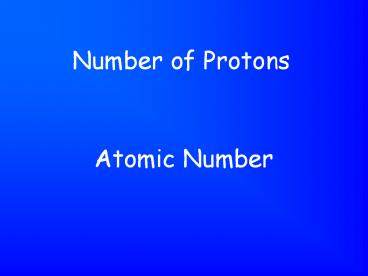Atomic Number - PowerPoint PPT Presentation
Title:
Atomic Number
Description:
Number of Protons Atomic Number Mass Number Number of Protons + Neutrons 12C Left Superscript = mass number 12C Left Subscript = atomic number 80Br 35 20Ne 20 27Al 27 ... – PowerPoint PPT presentation
Number of Views:142
Avg rating:3.0/5.0
Title: Atomic Number
1
Atomic Number
- Number of Protons
2
Mass Number
- Number of Protons Neutrons
3
12C
- Left Superscript mass number
6
4
12C
- Left Subscript atomic number
6
5
80Br
- 35
35
Atomic Number ?
6
20Ne
- 20
10
Mass Number ?
7
27Al
- 27
13
Mass Number ?
8
40Ca
- 20
20
Atomic Number ?
9
of electrons in a neutral atom?
- Neutral atoms have the same number of electrons
and protons.
10
Isotope
- Atoms of the same element with a different of
neutrons
11
Characteristics of Proton
- Charge 1, mass 1 amu, location inside
nucleus
12
Characteristics of Neutron
- Charge 0, mass 1 amu, location inside
nucleus
13
Characteristics of Electron
- Charge -1, mass 1/1836 amu or 0.0005 amu,
location outside nucleus
14
Ion
- An atom that has gained or lost electrons so
carries charge
15
Positive Ion
- An atom that has LOST electrons
16
Negative Ion
- An atom that has GAINED electrons
17
Charge
- protons - electrons
18
Nucleons
- Protons Neutrons
19
atom
- Smallest bit of an element that retains the
properties of the element.
20
of neutrons
- Mass number atomic number
21
14C
- 8 neutrons
- 6 protons
- 6 electrons
6
of neutrons ? of protons ? of electrons
?
22
9Be
- 5 neutrons
- 4 protons
- 4 electrons
4
of neutrons ? of protons ? of electrons
?
23
40Ar
- 22 neutrons
- 18 protons
- 18 electrons
18
of neutrons ? of protons ? of electrons
?
24
15N
- 8 neutrons
- 7 protons
- 7 electrons
7
of neutrons ? of protons ? of electrons
?
25
24Mg
- Right superscript charge
2
12
26
15N
- 8 neutrons
- 7 protons
- 10 electrons (gained 3)
-3
7
of neutrons ? of protons ? of electrons
?
27
19F
- 10 neutrons
- 9 protons
- 10 electrons (gained 1)
-1
9
of neutrons ? of protons ? of electrons
?
28
16O
- 8 neutrons
- 8 protons
- 10 electrons (gained 2)
-2
8
of neutrons ? of protons ? of electrons
?
29
23Na
- 12 neutrons
- 11 protons
- 10 electrons (lost 1)
1
11
of neutrons ? of protons ? of electrons
?
30
24Mg
- 12 neutrons
- 12 protons
- 10 electrons (lost 2)
2
12
of neutrons ? of protons ? of electrons
?
31
27Al
- 14 neutrons
- 13 protons
- 10 electrons (lost 3)
3
13
of neutrons ? of protons ? of electrons
?
32
Nuclear Charge
- Charge on the nucleus only. Does not include the
electrons. - Always positive.
- Equals the number of protons.
33
Cation
- Positive ion
34
Anion
- Negative ion
35
Daltons Model
- Billiard Ball Model
36
Daltons model
- Atoms are hard, round, indivisible. They are
solid uniform throughout.
37
Thomsons Model
- Plum Pudding Model
-
-
-
-
-
38
Thomsons model
- Atoms are divisible.
- They are solid but NOT uniform throughout.
- They contain and - charges.
- The charges are little particles.
39
Rutherfords Model
- Nuclear Model
-
-
-
40
Rutherfords model
- Atoms are divisible. Atoms are NOT solid. Atoms
are NOT uniform. - They contain and - charges.
- Most of the mass and all of the charge is
concentrated in the nucleus of the atom. - Most of the volume is empty space.
41
Rutherfords Experiment
- Shot a particles at gold foil.
- Most went through, so most of the atom is empty
space. - Some deflected back by small dense positive
nucleus.
42
Bohrs Model
- Planetary Model
43
atomic mass
- The mass of the entire atom includes protons,
neutrons, electrons. Expressed relative to the
mass of a C-12 atom.
44
atomic mass unit
- 1 atomic mass unit ? 1/12 the mass of a C-12
atom. - or
- The C-12 atom has a mass of 12.000 . . . atomic
mass units.
45
Average atomic mass
- The weighted average of the masses of the
naturally occurring isotopes of an element.
46
Average atomic mass
- Convert abundance to decimal format.
- Multiply abundance factor by appropriate mass.
- Sum
47
Quick check on average atomic mass calculation.
- Final answer must be between the highest lowest
masses. - Final answer will be closest to mass of most
abundant isotope.
48
Calculate the average atomic mass of Cl. 75 is
Cl-35 and 25 is Cl-37.
- 75 .75 and 25 .25
- (.75) X 35 26.25
- (.25) X 37 9.25
- 26.25 9.25 35.5 avg. atomic mass of Cl
- Ans is between 35 37, but closer to 35.































